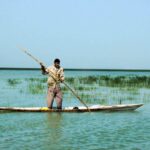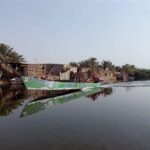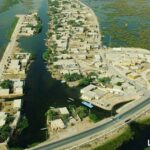Italy’s Venice is globally renowned, a must-see tourism destination that’s fascinated and enchanted visitors down the ages, with millions flocking to the city from around the world annually to travel through its streets by gondola and drink in its unique atmosphere. Far fewer people have heard of Sarakhiyeh village, the Venice of Ahwaz, whose Arab people use boats to move through its history-drenched, picturesque ancient streets.
The village is located in an oasis in the Falaheyeh wetland, around 110 kilometres from the city of Ahwaz and Muhammareh city and approximately 65 kilometres from the Iraqi border.
The Ahwazi villagers are rightly proud of their unique rural community on the water, which is visited by thousands of tourists every year, with locals using boats known as ‘balam’ to travel through the village and to visit neighbouring communities. Both the village itself and the surrounding wetlands are renowned for their beauty and peace.
The Falaheyeh wetland, where the village is situated is registered with UNESCO as one of the most important oases in Iran; combining both fresh and saltwater, it’s fed by the Jarahi and Karoon rivers, with the tide ebbing and flowing from the nearby Arabian Gulf. Covering an area estimated at around 400,000 hectares, it includes a wide array of plants, animals, domesticated fowl and seasonal migratory birds.
The entire local population in Sarakhiyeh and the neighbouring villages are Ahwazi Arabs who have made their living from fishing, farming, and raising and selling poultry for countless generations. Fiercely proud of their Arab culture and heritage, they preserve their Arabic language and customs, as well as continuing to use the traditional handicrafts passed down through the generations, with many tourists returning home with eye-catching basketwork souvenirs produced by weaving fronds from the local palm trees, a skill dating back literally millennia to around 5000 BC. Many Ahwazi villagers also augment their incomes by offering guided tours for the tourists who flock to the area.
Adel Kameli, the mayor of Sarakhiyeh, told DIRS that the village of around 15,000 residents is unique in the region due to being situated on a peninsula and effectively surrounded by water on all sides. with one-third of its people working in fishing in the oasis of Falaheyeh wetland which is famous for the delicious variety of fish exported to Iraq and the Gulf states.
Kameli revealed that the water level in the Falaheyeh oasis, whose depth ranges from 1.5 to metres according to season and water flow, now ebbs in summer due to the seasonal drought caused by the regime’s diversion of the Jarahi River’s waters to the Persian regions. He added that while most of the village’s residents subsist by raising cows, selling dairy products, and hunting, the village is currently plagued by illegal fishermen who use electric generators to catch fish, effectively electrocuting them, which puts the livelihoods and lives of local residents at risk. Life in Sarakhiyeh village is still traditional; without video games and mobile phones, the children spend their free time away from school in boat races, playing with skipping ropes and other traditional toys, and helping their parents raise livestock or hunt.
The best time to visit Sarakhiyeh and the surrounding area is either at the beginning of autumn or during spring when the mild weather makes tourism enjoyable, rather than during the searing summer heat and humidity or the heavy winter rains, which were so torrential in 2019 that the resulting flooding led to homes being submerged.
Tourists are enchanted at the unchanged nature of the village, wandering through its narrow alleyways, taking boat trips through its streets, or exploring the oasis of the Falaheyeh wetland. Visitors can watch birds and wild buffalos in the water, go fishing, tiptoe through sugar cane fields and relax in the peace and quiet away from the bustle of the city, as well as visiting the local museum and choosing from a wide selection of handicrafts and handmade artefacts made of wool and cane.
Sarakhiyeh residents prefer to use the traditional boats rather than motorboats to maintain the tranquillity of the village and avoid disturbing the many species of migratory birds and water buffaloes that graze in the waters there, with tourists also encouraged to use this traditional transport method or enjoy exploring the dry land areas on foot.
Sarakhiyeh’s villagers are typically generous Arab hosts, keen to share the local delicacies with friends, family and visitors alike, encouraging tourists to sample the deliciously sweet dessert known as Kharit, made from the locally grown sugarcane, which is also renowned for being a traditional medicine for maintaining a healthy stomach and bowels.
The local Ahwazi villagers say, “our livelihood here has always relied upon these wetlands, but the tourists who travel here do not appreciate our environment, and they throw their garbage and plastic in the water. The government has also not made any efforts to improve our living conditions. We are deprived of access to domestic gas pipes, which we need for heating and cooking, so we have to use our boats to travel to the city to fill gas tanks instead. We do not have a clinic or even a paved road.”
“If our area were part of Italy, we would have a better life, as the government would surely take care of our area and provide us with the basic needs such as trash containers, sustainable electric current to our homes, and build good schools for our children. But as we say, the winds always move against the will of our boats, because the Iranian government does not care about us at all. We are Ahwazi and Arab, and they do not care about us. We are scared that what will happen to our area if the oil companies expand their oil drilling to the wetland. It will mean the destruction of these precious wetlands, their birds and fish, and for us it will mean even more extreme poverty and then forced migration to places unknown.”
We are Ahwazi and Arab, and they do not care about us. We are scared that what will happen to our area if the oil companies expand their oil drilling to the wetland.
Sarakhiyeh ’s Ahwazi villagers are currently appealing to the Iranian authorities for greater government support due to the numerous environmental threats that endanger this idyllic rural way of life, including the aforementioned seasonal drought, as well as oil pollution and industrial waste seeping into the rivers waters, scaring off the dolphins once commonly seen round the village, along with an ancient and dilapidated sewage network, and the problems caused by the illegal fishing mentioned earlier. With help to promote its unique rural beauty and range of sights and experiences and to improve the environment, Sarakhiyeh could deservedly become even better known at home and abroad as a tourism destination to rival far better known spots and be restored to its past glory as a place of natural beauty, full of history amid wetlands hosting an awesome variety of wild animals and birds, many of which are now endangered.
By Rahim Hamid, an Ahwazi author, freelance journalist and human rights advocate. Hamid tweets under @Samireza42.






